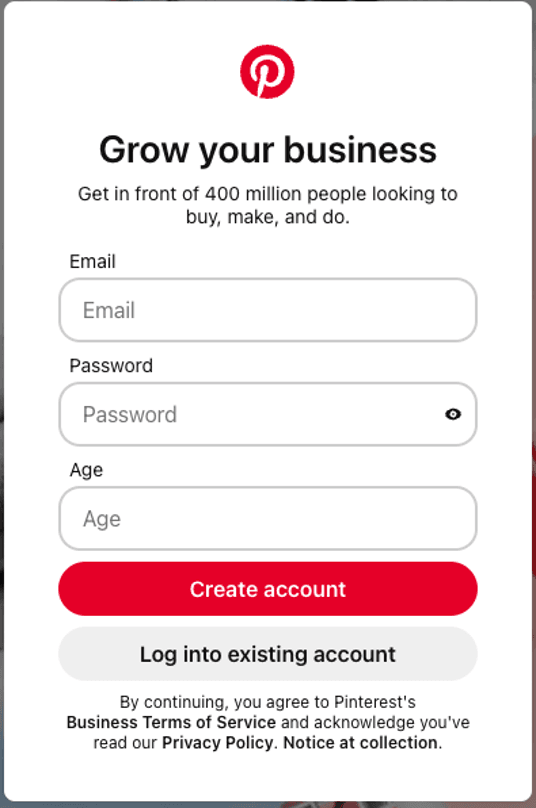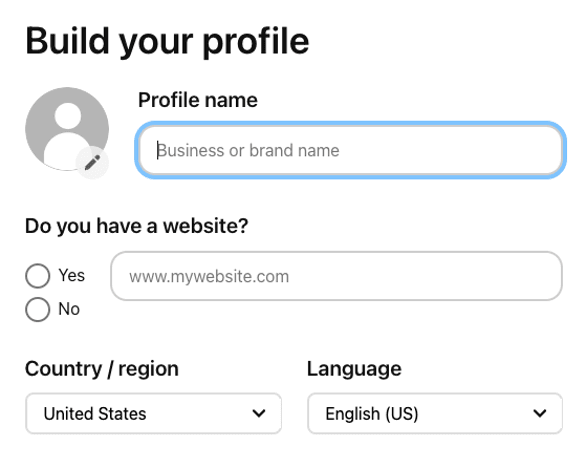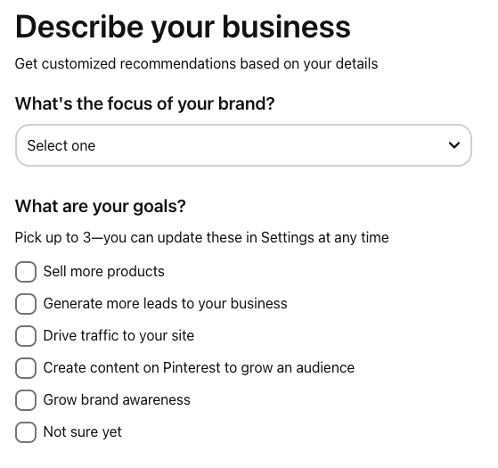Business News Daily provides resources, advice and product reviews to drive business growth. Our mission is to equip business owners with the knowledge and confidence to make informed decisions. As part of that, we recommend products and services for their success.
We collaborate with business-to-business vendors, connecting them with potential buyers. In some cases, we earn commissions when sales are made through our referrals. These financial relationships support our content but do not dictate our recommendations. Our editorial team independently evaluates products based on thousands of hours of research. We are committed to providing trustworthy advice for businesses. Learn more about our full process and see who our partners are here.
Pinterest for Business: Everything You Need to Know
Here's everything you need to know about using Pinterest for your business.

Table of Contents
If you’re not using Pinterest to market your products or services, you’re missing out – and so are your potential customers. With a visual-first format, Pinterest draws in viewers and sparks a desire to learn more. Not only that, many Pinterest users are there specifically to look for products and services – with 85 percent of users making a purchase because of the site, according to Pinterest – offering a great opportunity to find new customers that your traditional marketing channels may not reach.
Before you sign up and start pinning, here’s everything you need to know about using Pinterest for your business.
Pinterest basics
On Pinterest, users share and save content to virtual collections called boards. Most of the 450 million Pinterest members are female (more than 76 percent, according to Statista). While you can find just about anything on Pinterest – the website’s categories include everything from art to technology – it’s known as a hub for craft projects, recipes, fashion, home decor and health-related information.
If you want to use Pinterest to promote your small business, it’s important to sign up for a business account. Pinterest business accounts, which are free, give you access to sales-minded features such as analytics. If you already have a personal account, you can convert it to business or just create a new account.
Pinterest terminology
- Pins: All content shared on Pinterest is a pin – i.e., ideas to inspire you. When you click on a pin, it links to a website.
- Pincodes: Sort of like QR codes, Pincodes are special codes you can create to unlock your business’s curated boards and profile on Pinterest. Users can enter the code to be taken directly to your suggested boards.
- Pinners: This is what Pinterest calls its users.
- Boards: Sort of like visual bookmarks or digital bulletin boards, boards are how you organize your pins.
- Group boards: A group board is a collaborative board owned by one user. Owners can add other users to contribute to the board. You can ask to join a group board, but the board’s owner has to send you an invite.
- Archived boards: You can archive a board you no longer use but don’t want to delete. Archived boards won’t show up on your profile, and you’ll stop seeing suggestions related to the board. For example, you can opt-out of seeing wedding dresses after the big day has passed.
- Feed: Similar to a Facebook or Twitter feed, this is a group of pins from people you follow or what Pinterest thinks you’d be interested in.
- Hashtags on Pinterest: Hashtags on Pinterest work like they do on other social media platforms, like Instagram: They make it easy for other pinners to find your pins and relevant content.
- Lens: This feature in the Pinterest app uses your smartphone’s camera to suggest pins based on the pictures you take. For example, if you snap a picture of a product, it’ll show you similar products. You can choose to “explore” similar pins or choose “shop” to click to pins that are tied to an online store.
- Comments: You can add comments to other users’ pins.
- Save: When you click on a pin, you have the option to save, send or hide. When you save, you pin it to one of your boards.
- Sending pins: You can send pins to other users or non-Pinterest users in private messages.
- Tagging: You can tag other users using the @ symbol.
- Messages: You can send private messages to other Pinterest users.
Why your business should use Pinterest
Pinterest can benefit your business in a variety of ways. These are some of them:
Large user base
Pinterest is the seventh most popular social media platform in the U.S., with more than 39 percent of American adults using the platform, according to Oberlo. Using it can open your business to millions of new customers.
Visual platform
Pinterest is a great place to display your business visually. It’s also the only social media platform that currently supports visual search, so it’s a good idea to jump on this trend early.
Commercial activity
Consumers often use Pinterest to determine whether they want to make a purchase or to browse their options. And Pinterest makes it easy to go straight from exploring and searching to outright shopping.
Customer insights
Front and center in the business portal, you’ll find the Pinterest Insights hub. This is a great resource for seeing what’s currently trending and what’s predicted, as well as information on who the overall Pinterest audience is.
Brand exposure
Pinterest can boost your exposure to new customers, with a majority of users reporting that they discover new brands and products through Pinterest every week.
How to create a Pinterest profile
There are three main ways to create a Pinterest account: You can add a business profile to an existing personal account, convert your personal account to a business account or create a business account from scratch. Here’s how to create a profile, step by step:
1. Go to Pinterest.com/business/create.
If you already have a personal account, you’ll need to log out of it first. Enter your email and password. It’s a good idea to use a business email here to help differentiate your accounts. Click “create account.”

Source: Pinterest
2. Enter your business or brand name and add a link to your website.
Then, choose your language and location.

Source: Pinterest
3. Describe your business.
Enter a few details to help Pinterest customize your recommendations based on your business.

Source: Pinterest
4. Determine if you want to run advertisements on Pinterest.
You can always change this preference later, and you can also include your contact information so that a Pinterest ads rep can reach out to you.
5. Choose a starting point.
At this point, you can continue to build out your profile or create your first pin or ad.
Share ideas
Jump straight into creating your first pin to tell your brand story.
Grow your audience
Create an ad to reach more people right away.
Showcase your brand
Build your profile by adding a profile and a cover picture, location and more.
6. Claim your website analytics.
From your profile page, select Settings from the right-side arrow drop-down menu. On the Settings page, choose “Claimed accounts” from the menu on the left. On the next page, you can claim your website and install the free Pinterest app if you use Shopify.

Source: Pinterest
7. Start creating and pinning.
Now that you have set up your account, you can start creating boards and adding pins.
How to create boards, add pins and follow other users
From your profile page, click the “Create” drop-down menu in the upper-left corner. You can choose to create a pin or an idea pin. Idea pins used to be called “Story pins,” and they typically provide all the information you need to make a recipe or try a creator’s idea. The screenshot below shows the process for creating a regular pin.

Source: Pinterest
The drop-down “Select” menu lets you add a pin to an existing board or create a new one. If you use the Chrome browser, you can get an extension that allows you to pin right from a website.
In the Pinterest mobile app, you can now use your phone’s camera to find ideas. You simply open the app and point the camera at anything you’re interested in. The app will return with suggestions for similar things you might want to pin. For now, the company says this function is best at home decor ideas, clothing and food.
How to use Pinterest for business
1. Share creative, inspiring and actionable pins.
Pinterest is, first and foremost, a website for sharing pictures and inspiring ideas. If you want to succeed on Pinterest, you need to create and share visually pleasing and engaging pins. According to Pinterest, the most successful pins catch people’s attention and make them want to learn more. Great pins are typically vertical and show how to use a product or service.
2. Look at trending topics and keywords.
Trends on Pinterest can help you decide what content to pin or what your next product should be. For example, if you see that DIY projects are trending, that would be a good time to find and share DIY content that relates to your business, making your business more discoverable on Pinterest.
Content marketing consultant Camilla Hallstrom suggests using trending keywords to determine what type of content to create.
“Find relevant keywords by typing in a keyword in the search bar and checking the keyword suggestions you see right below the search bar,” she said. “Then, include those keywords in your titles and descriptions.”
3. Advertise on Pinterest.
Pinterest ads, or Promoted Pins, look like regular pins. The only difference is that you’re paying for your pins to be seen by more people.
“You can use geographic targeting so your ad will only be shown to people in your specified area,” said Marc Andre, blog manager and content strategist at Vandelay Design. “Depending on the topic and keywords used, Pinterest advertising can be pretty affordable … Some users will see your ad and re-pin it, and you’ll get that additional exposure from their re-pin without paying for it.”
Promoted Pins can have a snowball effect that drives more visibility to your pin than you’re paying for. It’s important to make Promoted Pins look helpful and like a regular pin, said Andre.

Source: Rakuten / Pinterest4.
4. Study Pinterest Analytics.
Pinterest Analytics gives you information about those viewing your page and pins. You can learn your audience demographics, the devices your visitors use and your most popular pins. You can also see data on your profile’s average daily impressions and viewers, your average monthly viewers, and average monthly engagements.
5. Add the Save button to your website.
Have you ever gone to a website, hovered over an image and seen a red Pinterest button pop up? That’s the Pinterest Save button, and it allows Pinterest users to pin your content to their boards directly from your website. Adding the Save button to your website makes it simpler to share your content, meaning more people are likely to do it.
6. Create fun, unique content.
There are many ways you can create fun and unique content while promoting your brand:
- Create gift guides. For holidays or other occasions, create a new board that can be used as a gift guide. Include products from other brands as well as your own so it doesn’t look like one giant advertisement for your business.
- Show off playlists. You’re not limited to pinning images. Try pinning music videos from YouTube to create a playlist board. With a huge fitness community on Pinterest, for example, this could be a good way for fitness-related companies to stray from the norm of sharing workout guides and exercise gear.
- Make a reading list. Save thoughtful articles and books related to your business with Pinterest by creating boards of all the good reads you think your customers would be interested in. You can also create secret boards with all the articles and books you’re dying to read in your spare time so they don’t get lost or forgotten in your bookmarks folder.
- Do giveaways. If you’re holding a contest or promotion, pin it to the relevant boards on your Pinterest page.
7. Use rich Pins.
Rich Pins are special pins that make using the platform more straightforward and seamless. These pins include information beyond the image, click-through link and pinner’s description. Perhaps best of all, these pins, if they’re linked to your website, update automatically when your website changes. Currently, there are three types of rich Pins:
- Article pins: Article pins make it so users can automatically see the article’s headline, author and story description, making them much more searchable and distinguishing them from other content on the platform.
- Product pins: Product pins make shopping on Pinterest a lot easier. They show where the product you’re pinning can be purchased, the current price and a direct link to the product page. Product pins’ prices update in real time.
- Recipe pins: Unlike a regular pin, which would show an image and a description that the pinner manually enters, these recipe-specific rich Pins show important information such as ingredients, cooking times and serving sizes.
You can find out more about rich Pins on Pinterest’s rich Pins page.
8. Participate in and create group boards.
A group board is a collaborative board owned by one person who can add others to contribute to it. This is a great resource if you’re planning a big event or working on a project, because multiple people can look at the board and pin ideas.
It’s also an easy way to get your pins in front of a lot of people, because more people typically follow group boards. The board owner’s audience sees the boards along with any of the collaborators’ followers.
“I write relevant blog posts with valuable content, create attractive pins with compelling headlines and pin them to the relevant boards on my profile as well as larger group boards with tens of thousands of followers,” said Kristin Marquet, founder and creative director of FemFounder.
9. Think of Pinterest as a search engine.
While Pinterest is a social media platform, it has a powerful search function. Many people go on the site to look for something in particular.
“When people are using Pinterest, they are often actively typing in searches to find what they’re looking for,” said Brian Wulfe, founder and CEO of Effective Spend. “On traditional social media, on the other hand, the audience is passively browsing the site.”
Since Pinterest is similar to a search engine, it’s important to properly label and categorize each pin and board.
Maximize the impact of Pinterest for business
Pinterest is a great vehicle for showcasing visuals of products and services and linking those back to your business. And Pinterest makes it easy for even small businesses to get started. Utilize its Help Center, analytics, trend reports and more to make sure you’re creating the right content to draw in and convert viewers to customers.
Jessica Pooree and Kiely Kuligowski contributed to this










